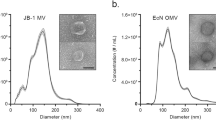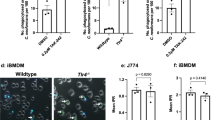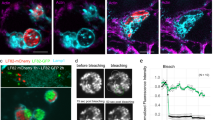Abstract
Strains of Escherichia coli persist within the human gut as normal commensals, but are frequent pathogens and can cause recurrent infection1,2,3. Here we show that, in contrast to E. coli subjected to opsonic interactions stimulated by the host's immune response, E.coli that bind to the macrophage surface exclusively through thebacterial lectin FimH can survive inside the cell following phagocytosis. This viability is largely due to the attenuation of intracellular free-radical release and of phagosome acidification during FimH-mediated internalization, both of which are triggered by antibody-mediated internalization. This different processing of non-opsonized bacteria is supported by morphological evidence of tight-fitting phagosomes compared with looser, antibody-mediated phagosomes. We propose that non-opsonized FimH-expressing E. coli co-opt internalization of lipid-rich microdomains following binding to the FimH receptor, the glycosylphosphatidylinositol-linked protein CD48, because (1) the sterol-binding agents filipin, nystatin and methyl β-cyclodextrin specifically block FimH-mediated internalization; (2) CD48 and the protein caveolin both accumulate on macrophage membranes surrounding bacteria; and (3) antibodies against CD48 inhibit FimH-mediated internalization. Our findings bring the traditionally extracellular E. coli into the realm of opportunistic intracellular parasitism and suggest how opportunistic infections with FimH-expressing enterobacteria could occur in a setting deprived of opsonizing antibodies.
This is a preview of subscription content, access via your institution
Access options
Subscribe to this journal
Receive 51 print issues and online access
$199.00 per year
only $3.90 per issue
Buy this article
- Purchase on Springer Link
- Instant access to full article PDF
Prices may be subject to local taxes which are calculated during checkout




Similar content being viewed by others
References
Brauner, A., Kaijser, B. & Kuhn, I. Recurrent Escherichia coli bacteraemia — clinical characteristics and bacterial properties. J. Infect. 28, 49–57 (1994).
Seneca, H. Urinary-tract infections: etiology, microbiology, pathophysiology, diagnosis and management. J. Am. Geriat. Sco. 29, 359–369 (1981).
Kreger, B. E., Craven, D. E., Carling, P. C. & McCabe, W. R. Gram-negative bacteremia. III. Reassessment of etiology, epidemiology and ecology in 612 patients. Am. J. Med. 68, 332–343 (1980).
Malaviya, R., Ikeda, T., Ross, E. & Abraham, S. N. Mast-cell modulation of neutrophil influx and bacterial clearance at sites of infection through TNF-α. Nature 381, 77–80 (1996).
Tewari, R. et al. Neutrophil activation by nascent FimH subunits of type 1 fimbriae purified from the periplasm of Escherichia coli. J. Biol. Chem. 268, 3009–3015 (1993).
Goetz, M. B. & Silverblatt, F. J. Phagolysosome formation by polymorphonuclear leukocytes after ingestion of Escherichia coli that express type 1 pili. J. Infect. Dis. 156, 229–233 (1987).
Keith, B. R., Harris, S. L., Russell, P. W. & Orndorff, P. E. Effect of type 1 piliation on in vitro killing of Escherichia coli by mouse peritoneal macrophages. Infect. Immun. 58, 3448–3454 (1990).
Gbarah, A. et al. Shigella flexneri transformants expressing type 1 (mannose-specific) fimbriae bind to, activate, and are killed by phagocytic cells. Infect. Immun. 61, 1687–1693 (1993).
Lock, R. et al. Neutrophil killing of two type 1 fimbriae-bearing Escherichia coli strains: dependence on respiratory burst activation. Infect. Immun. 58, 37–42 (1990).
Ofek, I., Goldhar, J., Keisari, Y. & Sharon, N. Nonopsonic phagocytosis of microorganisms. Annu. Rev. Microbiol. 49, 239–276 (1995).
May, A. K., Bloch, C. A., Sawyer, R. G., Spengler, M. D. & Pruett, T. L. Enhanced virulence of Escherichia coli bearing a site-targeted mutation in the major structural subunit of type 1 fimbriae. Infect. Immun. 61, 1667–1673 (1993).
Kisielius, P. V., Schwan, W. R., Amundsen, S. K., Duncan, J. L. & Schaeffer, A. J. In vivo expression and variation of Escherichia coli type 1 and P pili in the urine of adults with acute urinary tract infections. Infect. Immun. 57, 1656–1662 (1989).
Hagber, L. et al. Adhesion, hemagglutination, and virulence of Escherichia coli causing urinary tract infections. Infect. Immun. 31, 564–570 (1981).
Saukkonen, K., Cabellos, C., Burroughs, M., Prasad, S. & Tuomanen, E. Integrin-mediated localization of Bordetalla pertussis within macrophages: role in pulmonary colonization. J. Exp. Med. 173, 1143–1149 (1991).
Sturgill-Koszycki, S. et al. Lack of acidification in Mycobacterium phagosomes produced by exclusion of the vesicular proton-ATPase. Science 263, 637–639 (1994).
Eissenberg, L. G., Goldman, W. E. & Schlesinger, P. H. Histoplasma capsulatum modulates the acidification of phagolysosomes. J. Exp. Med. 177, 1605–1611 (1993).
Gbarah, A., Gahmberg, C. G., Ofek, I., Jacobi, U. & Sharon, N. Identification of the leukocyte adhesion molecules CD11 and CD18 as receptors for type 1-fimbriated (mannose-specific) Escherichia coli. Infect. Immun. 59, 4524–4530 (1991).
Sauter, S. L., Rutherfurd, S. M., Wagener, C., Shively, J. E. & Hefta, S. A. Identificaiton of the specific oligosaccharide sites recognized by type 1 fimbriae from Escherichia coli on nonspecific cross-reacting antigen, a D66 cluster granulocyte glycoprotein. J. Biol. Chem. 268, 15510–15516 (1993).
Wong, Y. W., Williams, A. F., Kingsmore, S. F. & Seldin, M. F. Structure, expression, and genetic linkage of the mouse BCM1 (OX45 or Blast-1) antigen. Evidence for genetic duplication giving rise to the BCM1 region on mouse chromosome 1 and the CD2/LFA3 region on mouse chromosome 3. J. Exp. Med. 171, 2115–2130 (1990).
Davis, S. J. & van der Merwe, P. A. Structure and ligand interactions of CD2: implications for T-cell function. Immunol. Today 17, 177–187 (1996).
Parton, R. G. Caveolae and caveolins. Curr. Opin. Cell Biol. 8, 542–548 (1996).
Schnitzer, J. E., Oh, P., Pinney, E. & Allard, J. Filipin-sensitive caveolae-mediated transport in indothelium: reduced transcytosis, scavenger endocytosis, and capillary permeability of select macromolecules. J. Cell Biol. 127, 1217–1232 (1994).
Yancey, P. G. et al. Cellular cholesterol efflux mediated by cyclodextrins. Demonstration of kinetic pools and mechanism of efflux. J. Biol. Chem. 271, 16026–16034 (1996).
Keller, G. A., Siegel, M. W. & Caras, J. W. Endocytosis of glycophospholipid-anchored and transmembrane forms of D4 by different endocytic pathways. EMBO J. 11, 863–874 (1992).
Clohisy, D. R., Bar-Shavit, Z., Chappel, J. & Teitelbaum, S. L. 1,25-Dihydroxyvitamin D3 modulates bone marrow macrophage precursor proliferation and differentiation. J. Biol. Chem. 262, 15922–15929 (1987).
Orndorff, P. E. & Falkow, S. Organization and expression of genes responsible for type 1 piliation in Escherichia coli. J. Bact. 159, 736–744 (1984).
Abraham, S. N., Sun, D., Dale, J. B. & Beachey, E. H. Conservation of the D-mannose-adhesion proteinamong type 1 fimbriated members of the family Enterobacteriaceae. Nature 336, 682–684 (1988).
Keith, B. R., Maurer, L., Spears, P. A. & Orndorff, P. E. Receptor-binding function of type 1 pili effects bladder colonization by a clinical isolate of Escherichia coli. Infect. Immun. 53, 693–696 (1986).
Berger, K. H. & Isberg, R. R. Intracellular survival by Legionella. Meth. Cell Biol. 45, 247–259 (1994).
Blueb, J. L., Gallois, A., Schneider, J. C., Parini, J. P. & Tschirhart, E. Adouble-labeling fluorescent assay for concomitant measurements of [Ca2+]iand O2production in human macrophages. Biochim. Biophys. Acta. 1244, 79–84 (1995).
Acknowledgements
We thank D. Haslam and I. Ofek for discussion, R. Henry for electron microscopy, and P. Orndorff for the gift of E. coli J96 and its FimH derivative. This work was supported in part by research grants from the NIH and from an award from the Jewish Hospital Foundation.
Author information
Authors and Affiliations
Corresponding author
Rights and permissions
About this article
Cite this article
Baorto, D., Gao, Z., Malaviya, R. et al. Survival of FimH-expressing enterobacteria in macrophages relies on glycolipid traffic. Nature 389, 636–639 (1997). https://doi.org/10.1038/39376
Received:
Accepted:
Issue Date:
DOI: https://doi.org/10.1038/39376
This article is cited by
-
Timing is everything: impact of development, ageing and circadian rhythm on macrophage functions in urinary tract infections
Mucosal Immunology (2022)
-
Comparative proteomics of related symbiotic mussel species reveals high variability of host–symbiont interactions
The ISME Journal (2020)
-
Differential interleukin-1β induction by uropathogenic Escherichia coli correlates with its phylotype and serum C-reactive protein levels in Korean infants
Scientific Reports (2019)
-
Otopathogenic Staphylococcus aureus Invades Human Middle Ear Epithelial Cells Primarily through Cholesterol Dependent Pathway
Scientific Reports (2019)
-
How type 1 fimbriae help Escherichia coli to evade extracellular antibiotics
Scientific Reports (2016)
Comments
By submitting a comment you agree to abide by our Terms and Community Guidelines. If you find something abusive or that does not comply with our terms or guidelines please flag it as inappropriate.



